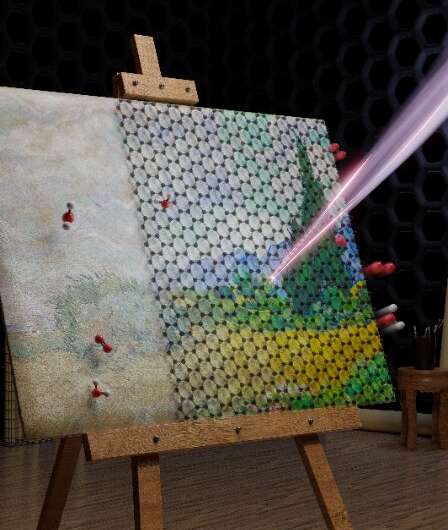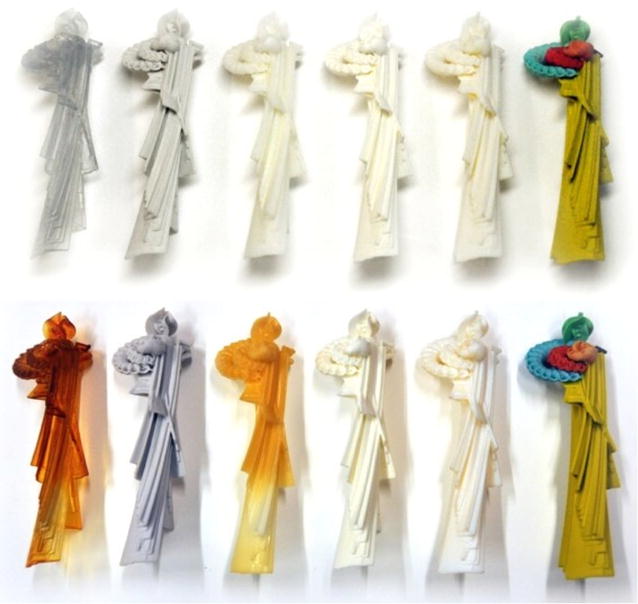A July 5, 2021 news item on phys.org announces a new technology for preserving and restoring your paintings,
The exposure of colors used in artworks to ultraviolet (UV) and visible light in the presence of oxidizing agents triggers color degradation, fading and yellowing. These degradation mechanisms can lead to irreversible alteration of artworks. Protective varnishes and coatings currently used to protect art paintings are not acceptable solutions, since their removal requires the use of solvents, which can affect adversely the underlying work surface.
A team of researchers from the Institute of Chemical Engineering Sciences of Foundation for Research and Technology-Hellas (FORTH/ ICE-HT), the Department of Chemical Engineering of the University of Patras, and the Center for Colloid and Surface Science (CSGI) of the University of Florence, led by Professor Costas Galiotis, had the innovative ideato use graphene veils for the protection of paintings against environmental degradation.
A July 2, 2021 Foundation for Research and Technology – Hellas (FORTH) press release, which originated the news item, provides more details,
Since its isolation in 2004 by Geim [Andre Geim] and Novoselov [Konstantin Novoselov] from the University of Manchester (Nobel Prize in Physics in 2010), graphene has been termed as a ‘wonder material’ due to its exceptional properties that have already been used in many applications and products. The graphene veil used in this work is a flexible, transparent film, produced by the technique of chemical vapor deposition. It has a monoatomic thickness and, since there are no size limitations in the other dimensions (length and width), it can cover any required large surface areas.
The results from measurements performed in the above mentioned laboratories, showed that this membrane is impermeable to moisture, the oxidizing agents and other harmful pollutants and also can absorb a large amount of harmful ultraviolet radiation. Finally, in contrast to other protective means, it is demonstrated that these graphene coatings are relatively easy to remove without damaging the surface of the artworks.

Before getting to the link and citation for the paper, here’s the abstract, which helps fill n a few more details,
Modern and contemporary art materials are generally prone to irreversible colour changes upon exposure to light and oxidizing agents. Graphene can be produced in thin large sheets, blocks ultraviolet light, and is impermeable to oxygen, moisture and corrosive agents; therefore, it has the potential to be used as a transparent layer for the protection of art objects in museums, during storage and transportation. Here we show that a single-layer or multilayer graphene veil, produced by chemical vapour deposition, can be deposited over artworks to protect them efficiently against colour fading, with a protection factor of up to 70%. We also show that this process is reversible since the graphene protective layer can be removed using a soft rubber eraser without causing any damage to the artwork. We have also explored a complementary contactless graphene-based route for colour protection that is based on the deposition of graphene on picture framing glass for use when the directapplication of graphene is not feasible due to surface roughness or artwork fragility. Overall, the present results are a proof of concept of the potential use of graphene as an effective and removable protective advanced material to prevent colour fading in artworks.
And now, a link to and a citation for the paper,
Preventing colour fading in artworks with graphene veils by M. Kotsidi, G. Gorgolis, M. G. Pastore Carbone, G. Anagnostopoulos, G. Paterakis, G. Poggi, A. Manikas, G. Trakakis, P. Baglioni & C. Galiotis. Nature Nanotechnology (2021) DOI: https://doi.org/10.1038/s41565-021-00934-z Published 01 July 2021
This paper is behind a paywall.
